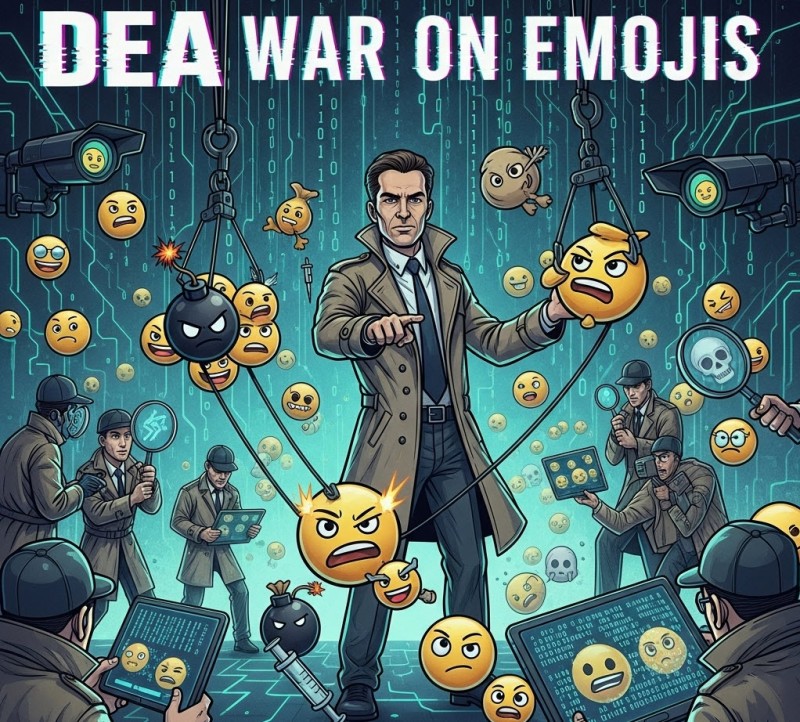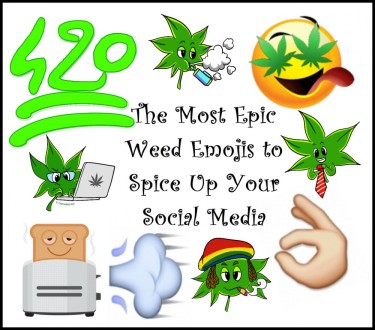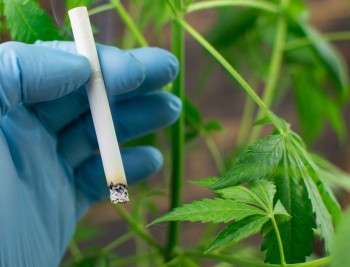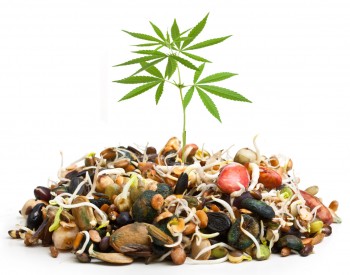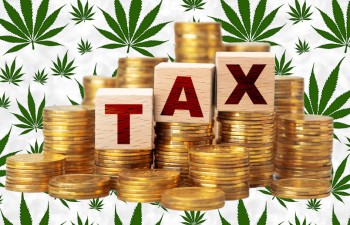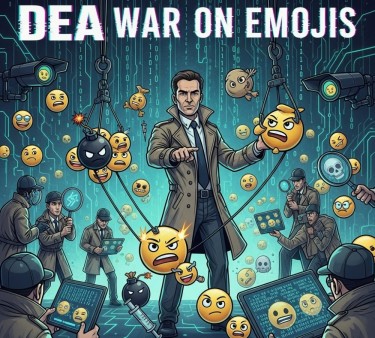
Hunter S. Thompson would have had a field day with the Drug Enforcement Administration's latest masterpiece of bureaucratic absurdity. In "Fear and Loathing in Las Vegas," Thompson satirized a police convention where cops discussed marijuana with the kind of breathless paranoia typically reserved for alien invasions. The fictional officers in Thompson's drug-fueled fever dream seem downright rational compared to the real-life DEA agents who've decided that the shocked face emoji (😮) represents marijuana and that bananas are secret code for oxycodone.
The DEA has released an "emoji decoding guide" that reads like a collaboration between Nancy Reagan's "Just Say No" campaign and a particularly unhinged conspiracy theorist's Pinterest board. According to our nation's premier drug enforcement agency, teenagers are using clovers, pine trees, dragons, cookies, and red maple leaves to orchestrate sophisticated drug trafficking operations through text messages. It's as if the DEA discovered the internet yesterday and decided that every symbol more complex than a smiley face must be part of an international drug conspiracy.
This isn't just bureaucratic incompetence - it's a $3.1 billion annual government agency that's completely lost touch with reality while claiming to protect American youth from emoji-based drug dealers. The same organization that's spent over 50 years failing to reduce drug use, overdose deaths, or drug-related crime has now decided that deciphering teenager text messages is a priority worthy of taxpayer funding and official government bulletins.
But the emoji guide isn't an isolated incident of DEA dysfunction - it's part of a broader pattern of an agency that's become so disconnected from its stated mission that it's essentially performing accidental performance art. From promoting Instagram influencer careers as drug alternatives to partnering with groups that spread "gateway drug" mythology, the DEA has transformed from a law enforcement agency into a parody of itself.
The time has come to ask the obvious question: why are we still funding this carnival of incompetence? When a government agency is more concerned with emoji interpretation than addressing the fentanyl crisis killing 80,000 Americans annually, maybe it's time to consider whether that agency serves any useful purpose beyond providing comic relief and employment for people who'd otherwise be writing conspiracy theories on internet forums.
Decoding the DEA's Decoder: A Guide to Government Delusion
Let's examine the DEA's emoji guide with the seriousness it deserves, which is to say, none whatsoever. According to our drug war experts, a banana emoji (🍌) represents fake prescription oxycodone. This raises immediate questions: are drug dealers really so sophisticated that they've developed fruit-based pharmaceutical coding systems, or are DEA agents so bored that they're inventing elaborate conspiracy theories to justify their existence?
The guide claims that an 8-ball emoji (🎱) represents cocaine, which might be the only entry that makes any sense since "8-ball" has been slang for an eighth of an ounce of cocaine for decades. But even a broken clock is right twice a day, and the DEA's emoji expertise doesn't improve from there.
Apparently, a cookie emoji means a "large batch" of illicit drugs. This suggests that drug traffickers are using baking metaphors to discuss inventory, which raises the question of whether the DEA thinks dealers are running underground bakeries or whether agents have been watching too many cooking shows during work hours.
The marijuana entries are where the guide truly enters the realm of science fiction. According to the DEA, cannabis is represented by fire, wind, pine trees, clovers, AND the shocked face emoji (😮). This comprehensive botanical and meteorological approach to marijuana coding suggests that either drug dealers have developed the most elaborate symbolic language in human history, or DEA agents are suffering from pattern recognition software malfunctions.
The shocked face emoji representing marijuana is particularly puzzling. Are users expressing surprise at marijuana's existence? Are they conveying amazement at its effects? Or did some DEA analyst see a teenager use 😮 in a text about being surprised by something and decide it must be drug-related because teenagers are always on drugs, according to DEA logic?
The brown heart and dragon emojis allegedly represent heroin, which implies that drug dealers are either romantic poets or fantasy game enthusiasts. The dragon connection is especially mysterious - are dealers referencing "chasing the dragon," or do they think heroin users are engaging in medieval role-playing games?
A red maple leaf supposedly represents "any drug," making it the universal solvent of emoji drug coding. This suggests that Canadian drug dealers have a significant advantage in international markets, or that the DEA thinks drug traffickers are extremely patriotic about autumn foliage.
The snowflake emoji for cocaine at least makes thematic sense, unlike the mushroom emoji for psychedelic mushrooms, which demonstrates either impressive literal thinking or a complete lack of imagination. When your drug coding system requires a mushroom to represent mushrooms, you might not be dealing with criminal masterminds.
The DEA's Greatest Hits: A Legacy of Absurdity
The emoji guide isn't an anomaly - it's the latest installment in the DEA's decades-long series of spectacular misunderstandings about youth culture, drug use, and basic human behavior. This is the same agency that once claimed that marijuana was more dangerous than cocaine, that insisted MDMA had no medical value while approving it for clinical trials, and that spent years fighting against needle exchange programs that demonstrably reduce disease transmission and overdose deaths.
In 2023, the DEA advised young people to avoid drugs by becoming Instagram influencers instead, apparently unaware that social media fame is itself a psychologically destructive pursuit that often leads to substance abuse. The agency promoted "7 Better Highs" including playing video games and visiting pet stores to look at animals, suggesting that DEA prevention specialists have the cultural awareness of particularly sheltered suburban parents from 1955.
The agency has also partnered with Johnny's Ambassadors, a group that promotes scientifically debunked "gateway drug" theories and blames high-potency cannabis for teenage suicide. The DEA hosted these propaganda memes on taxpayer-funded websites while simultaneously considering marijuana rescheduling, demonstrating either remarkable cognitive dissonance or a complete inability to coordinate messaging within their own organization.
Meanwhile, the DEA's core mission - reducing drug availability and drug-related harm - has been an unmitigated disaster for over 50 years. Drug overdose deaths have reached record levels, fentanyl has contaminated the entire illicit drug supply, and drug availability has increased rather than decreased despite billions in enforcement spending. The agency's response to this failure? Emoji interpretation guides and Instagram career advice.
The marijuana rescheduling process, which the DEA has been stalling for over a year, demonstrates the agency's fundamental dysfunction. After receiving overwhelming scientific evidence for marijuana's medical benefits and recommendations from the Department of Health and Human Services to reschedule cannabis, the DEA has responded with bureaucratic delays, legal challenges, and continued promotion of anti-marijuana propaganda.
This is an agency that simultaneously claims marijuana should be rescheduled for medical use while promoting campaigns that describe it as a dangerous gateway drug. It's an organization that spends resources decoding emoji while fentanyl dealers operate openly on social media platforms that require no decoding whatsoever.
The $3.1 Billion Question: Why Does the DEA Still Exist?
The DEA's annual budget of $3.1 billion represents one of the most expensive failures in government history. For half a century, this agency has consumed taxpayer money while failing to achieve any of its stated objectives. Drug use hasn't decreased, drug-related deaths have skyrocketed, and drug availability has increased. By any rational metric, the DEA represents a complete policy failure that should have been terminated decades ago.
The agency's current fixation on emoji interpretation while ignoring the fentanyl crisis that kills more Americans than car accidents demonstrates a complete disconnect from public health priorities. Instead of developing evidence-based harm reduction strategies, the DEA is creating fantasy narratives about teenage drug dealers using sophisticated symbolic communication systems to sell drugs through text messages.
This isn't just ineffective - it's actively counterproductive. The DEA's continued promotion of scientifically debunked anti-drug propaganda undermines legitimate drug education efforts and destroys the agency's credibility with the young people it claims to protect. When teenagers discover that authority figures have been lying to them about drugs, they're more likely to dismiss legitimate safety information along with the propaganda.
The agency's resistance to marijuana rescheduling despite overwhelming scientific evidence demonstrates institutional opposition to evidence-based policymaking. The DEA appears more committed to preserving its budget and authority than to implementing policies that serve public health and safety.
International drug policy experts have long recognized that enforcement-focused approaches like the DEA model have failed worldwide. Countries that have implemented public health-focused drug policies have achieved better outcomes in terms of overdose prevention, disease reduction, and crime reduction. The DEA's continued existence prevents the United States from adopting evidence-based policies that could save thousands of lives annually.
The resources currently wasted on DEA operations could be redirected toward treatment, harm reduction, mental health services, and evidence-based prevention programs that actually work. Instead, we're funding emoji interpretation while people die from contaminated drug supplies that could be eliminated through regulated markets.
The Abolition Solution: Life After the DEA
Eliminating the DEA wouldn't create chaos - it would create opportunities for rational drug policy based on public health rather than criminal justice approaches. The agency's enforcement efforts have demonstrably failed to reduce drug availability or drug-related harm, while consuming resources that could be used for effective interventions.
Drug regulation and quality control could be handled by existing agencies like the FDA, which has expertise in pharmaceutical safety and medical research. Treatment and prevention services could be expanded through the Department of Health and Human Services, which understands addiction as a medical condition rather than a criminal justice issue.
Local law enforcement could handle drug-related crimes that actually harm communities, like trafficking near schools or drug-related violence, without the DEA's expensive and ineffective federal bureaucracy. States that have legalized marijuana have demonstrated that regulated markets reduce rather than increase public safety problems.
International drug control cooperation could continue through other agencies without the DEA's counterproductive enforcement focus. Many countries are moving away from criminalization models toward public health approaches that achieve better outcomes with fewer resources.
The billions currently wasted on DEA operations could fund comprehensive addiction treatment, mental health services, harm reduction programs, and evidence-based prevention initiatives that address the root causes of problematic drug use rather than criminalizing the symptoms.
Most importantly, eliminating the DEA would end the institutional resistance to evidence-based drug policy that has prevented the United States from adopting effective approaches to drug-related problems. Without the DEA's bureaucratic inertia and ideological opposition to reform, policymakers could implement strategies that prioritize public health over punishment.
The Sticky Bottom Line: From Emoji Paranoia to Evidence-Based Policy
The DEA's emoji decoding guide represents everything wrong with American drug policy: expensive, ineffective, disconnected from reality, and actively counterproductive to public health and safety. When a government agency spends resources teaching parents that the shocked face emoji represents marijuana while fentanyl kills 80,000 Americans annually, that agency has lost any claim to legitimacy or competence.
Hunter S. Thompson's fictional police convention discussing marijuana paranoia was intended as satirical critique of drug war absurdity. The DEA has managed to make Thompson's parody seem reasonable by comparison. At least Thompson's fictional cops were discussing actual marijuana rather than interpreting emoji symbols as evidence of international drug conspiracies.
The time has come to acknowledge that the DEA experiment has failed catastrophically and should be terminated. Fifty years and hundreds of billions of dollars have produced nothing but emoji interpretation guides, Instagram career advice, and steadily worsening drug-related problems. No private organization with this record of failure would survive in a competitive market, yet taxpayers continue funding this bureaucratic disaster year after year.
Ending the DEA wouldn't mean abandoning drug policy - it would mean implementing evidence-based approaches that prioritize public health over punishment, treatment over imprisonment, and harm reduction over moral crusading. Countries that have adopted these approaches have achieved better outcomes with fewer resources and less social disruption.
The choice is clear: continue funding emoji paranoia and bureaucratic incompetence, or redirect those resources toward policies that actually work. The DEA has had half a century to prove its effectiveness and has instead produced a guide claiming that bananas represent oxycodone.
It's time to decode the real message here: the DEA is a $3.1 billion joke that's no longer funny because real people are dying while bureaucrats interpret emoji. End the charade, eliminate the agency, and implement drug policies based on evidence rather than emoji analysis.
The shocked face emoji (😮) shouldn't represent marijuana - it should represent taxpayer reaction to learning how their money is being wasted on this bureaucratic comedy show.

